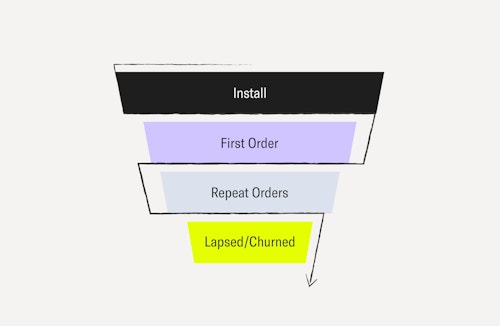How in-app retargeting complements your UA strategy
January 31, 2023

User acquisition is just a small piece of the puzzle
One of the top-level metrics that app-based businesses concern themselves with is the volume of installs and new users that they are getting. An app’s installation rate is important because it helps them (and their investors) to understand the demand for their product. If an app shows a high volume of new installs, it’s a good indication that they’ve achieved widespread brand awareness and that they have a strong product-market fit.
Demonstrating growth potential is an important first step in proving your viability as a business, which is why apps will often focus their marketing resources into user acquisition (UA) campaigns. Ensuring a constant flow of installs and new users makes sense, because the installation and registration process is an important step in the sales funnel. However, acquiring a user doesn’t guarantee that they’ll go on to make a purchase, or even use the app. A recent AppsFlyer report uncovered that in 2022, 49% of apps were uninstalled within the 30 days after they were downloaded – and almost half of those uninstalls took place within just 24 hours.
While it may vary according to product type and industry, it’s estimated that the average purchase requires at least seven marketing touch points – meaning that your marketing efforts can’t just stop after the initial installation. Ekaterina Li, principal account manager at Remerge explained at the Mobidictum conference in Istanbul: “User acquisition by itself isn’t enough. Many studies show that around 90% of daily active users will churn in the seven days after installing an app, so your investment in UA won’t be worth much unless you build a robust retention strategy from day one.”
« Keeping users within an app is cheaper and more cost effective than acquiring a new install. »
Kate Taganova, director of sales for EMEA
What is a full-funnel marketing strategy and where does retargeting fit in?
The typical marketing funnel for most digital and app-based businesses usually begins with general awareness campaigns that are designed to make potential customers familiar with your brand. The messaging doesn’t necessarily require a call to action as the goal is simply to establish brand recall. The next step in the funnel is the consideration stage, where the ad encourages the audience to check out the products and services on offer. Some of the audience may click through to a landing page to learn more, and some may even make a purchase. Data on these customer actions is what informs the strategy behind the final and most crucial stage – retargeting.
Once your top-of-funnel ad campaigns begin bringing in a consistent flow of engagement from both potential and existing customers, you can then shift your focus to running retargeting ads. Those who view your retargeting ads are already familiar with your brand, so you can use more tailored messaging to encourage customers to perform specific, (and often) conversion-oriented actions that take place at the bottom of the funnel. This could be purchasing a product that they previously looked at, or claiming a discount as a reward for being a loyal, returning customer.

Ultimately, users who meet the criteria for your retargeting ads are among the most valuable because they are more likely to make a purchase than users who have never heard of your product. In this sense, retargeting campaigns compliment your UA strategy because they reduce churn, generate revenue and increase a user’s overall lifetime value (LTV). However, it’s also worth noting that the timing of your retargeting ads is critical. For some types of app-based businesses, it’s believed that retargeting users beyond seven days since their last touchpoint is already too late to make an impact.
Why retargeting matters
Steve Massaro, director of channel alliances at Remerge explains to the Drum Magazine: “New users can fall off the funnel in many places and how you re-engage with them should depend on where that is. Maybe someone who recently installed your app doesn’t complete the registration process. Perhaps they abandon their cart in your store or they no longer engage with your brand after making a one-time purchase. Testing and iterating campaigns to address all these stages is the key to successfully guiding customers through your sales funnel and encouraging them to continue making purchases.”
There are also plenty of reports on retargeting that attest to its efficacy. According to one study, users exposed to retargeting campaigns have an overall 152% higher engagement rate (number of in-app events per user) in the 30 days after install compared to users who were not retargeted. On day one of install, the engagement rate is even higher at 200% for the retargeted group. Not only that, but they also drive on average 37% more revenue events in the first 30 days than those who are not retargeted.
Speaking on the topic at the 2022 App Promotion Summit in Berlin, Remerge’s director of sales for EMEA, Kate Taganova explains: “With all the current budget cuts, it’s more important than ever to invest money as wisely as possible and bring our clients additional value. The fact is that keeping users within an app is cheaper and more cost effective than acquiring a new install, especially when we talk about maturer apps where the cost per install (CPI) only gets higher.”
Kate Taganova at the App Promotion Summit
Summary
Given the compelling research out there, it’s fair to say that user acquisition campaigns only drive temporary and short-lived business success because the majority of newly acquired users are statistically unlikely to become loyal, long-term customers. Incorporating retargeting campaigns into your mobile marketing strategy is what helps you to identify your loyal customers, reduce their likelihood of churning and increase their overall lifetime value (LTV) – which is, as Steve Massaro puts it, “the key to your sales revenue and return on ad spend.”
Get the latest app marketing insights
Join our newsletter





